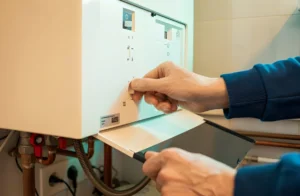
Whether you’re running music festivals, trade shows, stadiums, or corporate shindigs, venues always run into the same problem: handling big crowds easily and safely. Lines that never end, slow entry, and people sneaking in not only annoy attendees but also put safety and how well things run at risk.
That’s where waist height turnstiles come into play. They’re not just barriers; these access control tools are a fresh fix for old-fashioned entry. Adding them to event check-in tech has totally changed how venues work, especially now that everyone wants—and often expects—contactless entry.
This blog looks at why every venue, no matter how big or what it’s for, can gain from installing waist-height turnstiles. We’ll look at what’s good about them, how flexible they are, and how important they are for a safe, contactless, and expandable access setup.
Understanding the Waist Height Turnstile
A waist-height turnstile is basically a gate that’s about waist high. It’s a system, either with moving parts or electronic, that lets one person through at a time. You’ve probably seen them at subway stations, sports stadiums, and even events now.
Compared to those tall, enclosing turnstiles, these are less scary and easier to use. They’re good when you want things to move quickly and still look decent. You can control them by hand or hook them up to a system that does it automatically, making them work with bigger security setups.
Tripod Turnstile Gate: A Closer Look
When it comes to waist-high gates, the tripod turnstile is super popular. It’s got three arms that spin around to let people in or keep them out. Here’s why people like them:
- Simple: They’re easy to use and don’t have a lot of extra stuff.
- Tough: They can handle tons of people going through them every day.
- Flexible: You can put them inside or outside.
- They work with cards, codes, or even fingerprints.
Because they don’t take up much space and are cheap, event folks and building managers pick these gates a lot.
Why You Should Get a Waist Height Turnstile?
The best thing about these turnstiles is that they keep entry in check. Think about it: when tons of folks show up all at once, things get jammed up. These turnstiles help keep things moving smoothly, so you don’t need loads of staff at the door.
Here’s how:
- One person gets through at a time.
- Less crowding when it’s busy.
- Keeps people from cutting in line or big crowds from pushing through.
1. Better Security Right Away
Security is super important for any event or public space. Turnstiles that are waist-high help stop people from getting in who shouldn’t. If you use them with things like ID badges, tickets, or QR codes, you can make sure only people who are allowed get in.
What this means for places:
- You don’t need as many security people.
- Less chance of fake tickets being used.
- It makes it harder for people to break the rules.
2. Quick, Touch-Free Event Check-Ins
Because of the pandemic, everyone wants touch-free event check-ins. Waist-height turnstiles can do this by working with digital stuff like:
- Mobile ticket apps.
- Face recognition.
- RFID and NFC passes.
This switch cuts down on contact, keeps things cleaner, and gets people in faster. Plus, organizers can easily keep digital records.
Why It’s a Game-Changer for Events and Venues?
From corporate conferences to music festivals, turnstiles for events are becoming essential. Here’s why waist height turnstiles stand out:
- Portable models are available for temporary setups.
- Compatible with third-party software for seamless ticket scanning.
- Occupy minimal space at entrances.
They’re suitable for a wide variety of venues, including:
- Stadiums
- Exhibition centers
- Universities
- Co-working spaces
- Amusement parks
Real-Time Monitoring & Data Analytics
Today’s turnstiles are not just the old mechanical gates. They’re actually smart devices. With the way things are set up now, venue managers can grab useful data, like:
- How many people go in and out?
- When the most people come in?
- How long do people spend inside?
- If people come back often.
This info is great for making staffing choices, tightening security, and figuring out event layouts. That helps things run smoother and makes for a better time for everyone.
Waist-high Turnstiles Compared to Other Entry Methods
Compared to doing things the old way with manual check-in:
- Manual check-in can be slow because people have to write stuff down, or you have to scan things.
- People make mistakes. It happens.
- You need more staff, and it’s hard to handle more people if things get busy.
Waist-high turnstiles automate entry. This makes things faster and more secure and means you don’t have to rely on as many staff.
Compared To Full-Height Turnstiles
- Full-height turnstiles are more secure. But they can also look kind of scary to people.
- They don’t really work indoors or in fancy areas.
- Plus, they’re a pain to install if you don’t have much space.
Waist-height ones are a good middle ground. You still get some security, but they look nicer and people like them better, especially if your event is all about looking good and working smoothly.
Event Check-In Solutions: Where Turnstiles Fit In
The modern event landscape is digital-first. That means check-in solutions must work with:
- QR codes issued via email.
- Mobile wallet tickets.
- Smart wearables like NFC wristbands.
- Biometric scanning.
Waist height turnstiles can easily be configured to communicate with event software, automatically validating passes without human intervention.
This helps:
- Eliminate fake or reused tickets.
- Minimize wait times.
- Provide a tech-savvy, professional image for the event.
Easy to Change and Grow
Whether you’re putting on a small class or a big convention, these turnstiles can work for you:
- Start with just a turnstile or two if it’s small.
- Add more as more people come.
- Take the portable ones to different places when needed.
This means you don’t have to spend too much at first, but you’re still ready if things get bigger.
Choosing the Right Waist Height Turnstile for Your Venue
What Features Should You Look For?
If you’re considering installing one, here’s what you should evaluate:
- Build quality: Stainless steel for durability.
- Motor type: Electromechanical for smoother operation.
- Speed: Faster cycle time means quicker entry.
- Compatibility: Can it integrate with your existing software?
- Fail-safe vs. fail-secure: How it behaves during power outages.
Tips for Choosing a Vendor
Not all turnstiles are created equal. When choosing a supplier:
- Look for vendors who offer customization (branding, finishes).
- Check for on-site support or remote troubleshooting.
- Ask for integration documentation and API support.
- Read reviews and ask for case studies from similar venues.
Investing in the right solution upfront saves both time and money in the long term.
Last words
No matter if it’s a huge international thing or just a small local get-together, you need to make a good first impression right when people walk in. A short turnstile is a good way to handle entry, mixing security, ease, and new tech into one simple setup.
Picking the right turnstile isn’t just about making things move faster and stay safer. You’re also setting things up to handle newer digital check-in tech. Nowadays, ease of use and safety are both important, so this small change can really make a big difference.
If you’re putting together an event or making updates to your place, think about more than just old-fashioned entry tech. Short turnstiles aren’t only convenient—they’re kind of a must-have if you want to do touch-free, techy stuff.



